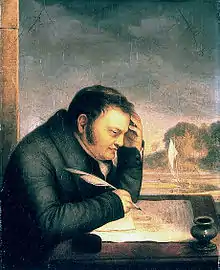Friedrich von Nerly
Friedrich von Nerly, originally Christian Friedrich Nehrlich (24 November 1807, Erfurt - 21 October 1878, Venice) was a German painter in the Romantic Style; primarily known for his vedute of Venice. He is sometimes referred to as "The Elder", to distinguish him from his son, the painter Friedrich Paul Nerly. His first name is also seen as "Federico" and "Federigo".

Biography

His father, a postal official in Erfurt, died while Friedrich was still a boy. From 1815, he was raised by an uncle, who was a musician, in Hamburg. He received his first drawing lessons from his aunt, then from another uncle, Heinrich Joachim Herterich, a lithographer, and was employed in his workshop. He also made friends with Herterich's partner, Johann Michael Speckter, and his family. Through them, he made the acquaintance of the person who would become his patron; the painter and art historian, Carl Friedrich von Rumohr. In 1823, he became one of Rumohr's students. Four years later, they took an extended trip that led to Italy, through the Harz Mountains.
At the end of 1828, they reached Rome and he decided to stay there. It was then that he changed his name to "Nerly", apparently believing it sounded more Italian. He soon took over managing the "Cervaro Festival" for the Deutscher Künstlerverein (German Artists' Association) of Rome. He would hold that position until his departure in 1835.
After a short tour of Southern Italy, he settled in Venice and began painting the views of the city for which he is best known. In 1840, he married Agathe Alginovich (1810–89), adoptive daughter of the Marchese Maruzzi, and they had one son, Friedrich Paul, who also became a painter.
In 1852, King William I of Württemberg awarded him the Knight's Cross in the Order of the Crown, which gave him the right to use the noble prefix "von".[1]
In 1883, his entire art collection was donated to the city of Erfurt by his son, Friedrich, with the stipulation that it be used to create a museum. This was done, and the Angermuseum opened in 1886. (Anger is German for "town commons").[2] A street in Erfurt is named after him.[3]

References
- Hof- und Staatshandbuch des Königreichs Württemberg, 1877, pg.41.
- Steffen Raßloff: Eduard von Hagen und die Gründung des Angermuseums In: Kulturjournal Mittelthüringen. #6/2009. pg.32.
- Erfurter Statistik Straßenverzeichnis 2012 in the Internet Archive
Further reading
- Constantin von Wurzbach: Nerly, Federigo. In: Biographisches Lexikon des Kaiserthums Oesterreich (Biographical Lexicon of the Empire of Austria). Part 20 Kaiserlich-königliche Hof- und Staatsdruckerei, Vienna 1869, p. 186–188 (digitalised).
- Friedrich Pecht (1886), "Nerly, Federico von", Allgemeine Deutsche Biographie (ADB) (in German), 23, Leipzig: Duncker & Humblot, pp. 435–436
- Friedrich Nerly und die Künstler um Carl Friedrich Rumohr, exhibition catalog, Kloster Cismar, Schleswig-Holsteinisches Landesmuseum; Landesmuseum Mainz, 1991.
- Thomas Gädeke (1999), "Nerly, Federico von", Neue Deutsche Biographie (NDB) (in German), 19, Berlin: Duncker & Humblot, pp. 65–66; (full text online)
External links
| Wikimedia Commons has media related to Friedrich von Nerly. |
- "Works by Friedrich von Nerly". Zeno.org (in German).
- Literature by and about Friedrich von Nerly in the German National Library catalogue